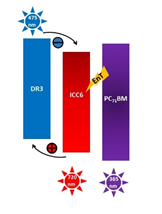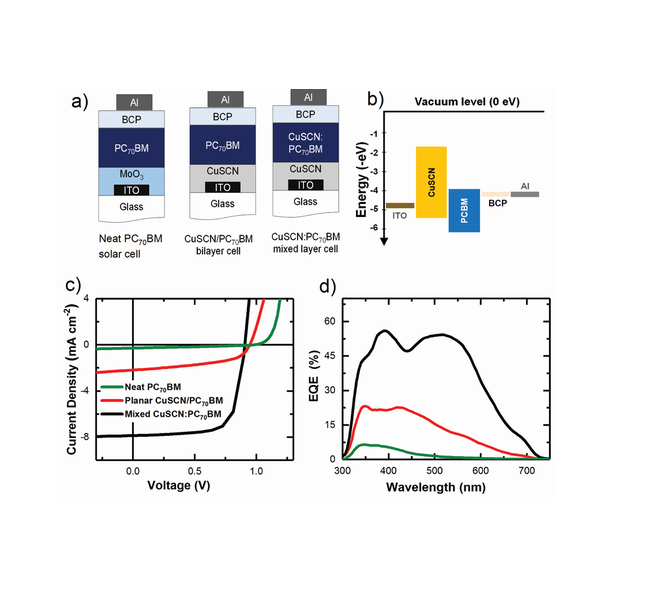Organic Photovoltaics:

Impact of Fullerene on the Photophysics of Ternary Small Molecule Organic Solar Cells - Our recent work published in Advanced Energy Materials (Karuthedath et al., Adv. Energy Mater. 2019,1901443) discusses the impact of fullerene on the photo physics of ternary small molecule non-fullerene acceptor (NFA) solar cells. We observed that after excitation of PC71BM, ultrafast singlet energy transfer to the NFA (ICC6) occurs. The singlet states on ICC6 then undergo hole transfer to DR3 (the small molecule donor), leading to free charge generation. Interestingly, PC71BM has a dual role: firstly, it increases the blend’s photoresponse in the UV spectral region and secondly it improves the electron mobility of the ternary blend, resulting in less recombination and faster electron extraction. Finally, we used the (photo) physical parameters obtained from (transient) spectroscopy and charge transport measurements to simulate the device's current–voltage characteristics and we found that the simulation accurately reproduces the experimentally-measured device JV-characteristics.
Charge and Triplet Exciton Generation in Neat PC70BM Films and Hybrid CuSCN:PC70BM Solar Cells - We recently investigated charge and triplet exciton dynamics in neat fullerene and fullerene-rich hybrid solar cells by means of transient spectroscopy (Karuthedath et al. Adv. Energy Mater., 2018, DOI: 10.1002/aenm.201802476) . The efficiency and mechanism of charge generation and triplet formation depend on the photoactive layer composition. Formation of a hybrid bulk heterojunction leads to ultrafast exciton dissociation, fast charge extraction, and PCEs in excess of 5%. In neat PC70BM films, charge generation is slow and occurs with low yield, while the hybrid films show ultrafast generation due to the presence of abundant interfaces, facilitating charge separation. In PC70BM films, the triplet exciton generation is proportional to the product of singlet and charge concentrations, indicating a charge–singlet spin exchange mechanism. In hybrid films however, the triplet formation is a consequence of non-geminate recombination of charges. At low fluences, the fraction of charges outweighs the population of triplets in both, blends and neat films, leading to respectable device efficiencies under one sun illumination.
